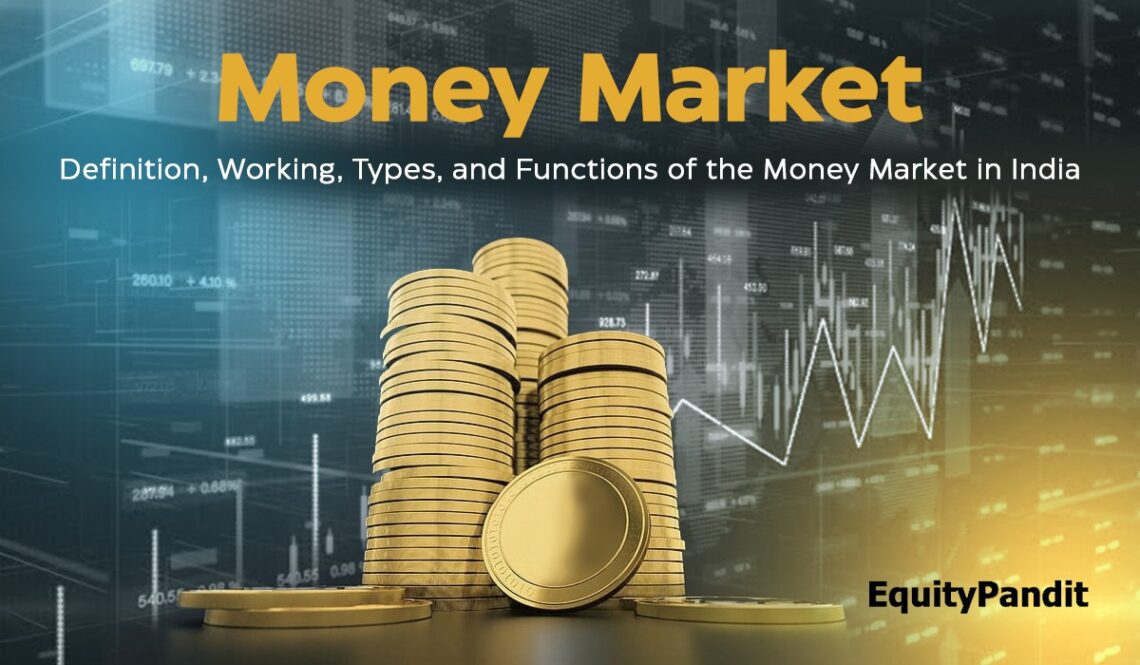Let’s rewind to a few years back when I was fresh out of college, juggling my first job and a pile of student loans. The stock market felt like a rollercoaster I wasn’t ready for, so I dipped my toes into something safer – a money market account at my local bank. It wasn’t glamorous, but watching that steady interest trickle in gave me a sense of control amid the chaos. That’s the quiet power of the money market: a financial haven where short-term needs meet reliable liquidity. In this guide, we’ll break it down from the basics to the nitty-gritty, exploring what it is, how it operates, the various types, and its essential roles in the economy. Whether you’re a beginner saver or a seasoned investor, understanding this market can help you navigate financial waters with confidence.
What Is the Money Market?
At its core, the money market is a segment of the financial world focused on short-term borrowing and lending. It deals with high-quality debt securities that mature in less than a year, providing a platform for governments, banks, and corporations to manage cash flow efficiently. Unlike the stock market’s volatility, this one prioritizes stability and quick access to funds.
It’s often called the “wholesale” market because trades happen in massive volumes, sometimes billions overnight. This setup ensures liquidity – the ability to convert assets to cash without losing value – which is crucial for economic stability.
Defining the Money Market in Simple Terms
Think of it as a bustling marketplace for short-term loans, where participants trade instruments like treasury bills or commercial paper. These are essentially IOUs promising repayment soon, often within days or months. It’s not about long-term growth but immediate financial needs.
From my early banking days, I saw it as a safety net – a place where excess cash earns a bit while staying ready for emergencies. This definition highlights its role in balancing supply and demand for short-term funds.
Key Characteristics of the Money Market
High liquidity stands out, meaning assets sell quickly without price drops. Low risk is another hallmark, backed by strong credit ratings or government guarantees. Transactions are large-scale, typically over $100,000, making it more institutional than retail.
Interest rates here are influenced by central banks, like the Federal Reserve’s fed funds rate. This keeps things predictable, appealing to conservative investors.
How Does the Money Market Work?
The money market operates through a network of buyers and sellers exchanging short-term debt. Banks might lend excess reserves overnight to others in need, earning interest in the process. It’s all about matching lenders with borrowers for brief periods, often facilitated by brokers or electronic platforms.
Daily volumes can hit trillions globally, with the U.S. market alone seeing massive activity. Rates fluctuate based on supply, demand, and economic signals, but they stay low due to short maturities.
The Mechanics of Money Market Transactions
Trades happen over-the-counter, not on exchanges like stocks. A corporation issues commercial paper to raise quick cash, selling it at a discount to investors who get face value at maturity. It’s straightforward: borrow cheap, repay soon.
In my experience advising friends on savings, I explain it as a relay race – money passes hands swiftly to keep the economy running smoothly. This process ensures funds are always available where needed most.
Role of Participants in the Money Market
Banks act as key players, borrowing to meet reserve requirements or lending surpluses. Corporations use it for working capital, while governments fund short-term deficits via treasury bills. Mutual funds pool retail money into these instruments.
Individual investors join indirectly through money market accounts or funds. Everyone benefits from the market’s efficiency in allocating resources.
Types of Money Market Instruments
Variety defines this market, with tools tailored to different needs. From government-backed securities to corporate notes, each type offers low-risk options for short-term parking of funds. Understanding these helps in choosing the right fit for your portfolio.
Common ones include treasury bills, known for safety, and certificates of deposit, which lock in rates. Commercial paper suits businesses needing fast cash.
Treasury Bills (T-Bills)
These are U.S. government-issued debts with maturities from days to a year, sold at a discount. Investors earn the difference at maturity, making them virtually risk-free. They’re auctioned weekly, appealing to conservative holders.
I once parked emergency savings in T-bills during market dips – the peace of mind was worth the modest returns.
Certificates of Deposit (CDs)
Offered by banks, CDs promise fixed interest for terms under a year in the money market context. They’re FDIC-insured up to $250,000, providing security. Early withdrawal penalties apply, encouraging commitment.
They’re great for savers wanting better rates than regular accounts without stock risks.
Commercial Paper
Unsecured promissory notes from corporations, maturing in 1-270 days. Issued at discounts, they’re for high-credit firms funding operations. Not insured, but short terms minimize default risk.
Big companies like Apple use them for payroll or inventory – efficient and cost-effective.
Repurchase Agreements (Repos)
These involve selling securities with a buyback promise soon after, often overnight. Used by banks for liquidity, they’re collateralized by treasuries. Rates are low, reflecting safety.
Central banks employ repos in monetary policy, injecting or draining cash as needed.
Bankers’ Acceptances
Short-term drafts guaranteed by banks, common in international trade. They finance imports/exports, maturing in 30-180 days. Traded at discounts, they’re reliable for global deals.
Exporters benefit, as banks’ backing reduces payment worries.
Eurodollars
U.S. dollar deposits in foreign banks, outside Fed regulations. They offer higher rates due to less oversight, with short maturities. Popular in London, they’re key for multinational firms.
They highlight the global nature of money markets.
Functions of the Money Market
This market isn’t just trading; it underpins economic health. It provides liquidity, helping entities manage cash shortfalls. By channeling idle funds to productive uses, it boosts efficiency.
It also influences interest rates, guiding broader financial conditions. Central banks use it to implement policies.
- Finances trade by discounting bills of exchange.
- Supports industry with working capital loans.
- Allows profitable investment of bank reserves.
- Enhances bank self-sufficiency in crises.
- Aids central banks in monetary control.
Providing Liquidity to the Financial System
It ensures quick cash access, preventing disruptions. Banks borrow overnight to meet reserves, maintaining stability. This function keeps the economy fluid.
During the 2008 crisis, money markets froze – a reminder of their vital role.
Facilitating Short-Term Borrowing and Lending
Governments and firms borrow affordably for immediate needs. Lenders earn on surpluses without long ties. It’s a win-win for cash management.
My small business owner pal uses it for seasonal inventory – keeps operations humming.
Influencing Interest Rates and Monetary Policy
Rates here set benchmarks for loans and mortgages. Central banks adjust via open market operations. This steers inflation and growth.
Fed rate hikes ripple through, cooling or heating the economy.
Comparing Money Market vs. Capital Market
Money markets focus on short-term debts, while capital markets handle long-term investments like stocks and bonds. The former prioritizes liquidity; the latter, growth.
Both are essential, but risks and returns differ sharply.
| Aspect | Money Market | Capital Market |
|---|---|---|
| Maturity | Under 1 year | Over 1 year |
| Risk Level | Low | Higher |
| Instruments | T-bills, CDs, Commercial Paper | Stocks, Bonds, Mortgages |
| Purpose | Liquidity management | Long-term financing |
| Participants | Banks, Corps, Govts | Investors, Companies, Individuals |
| Returns | Low but stable | Potentially high, volatile |
This table shows their complementary roles.
Pros and Cons of Investing in Money Markets
Pros: High liquidity for quick access; low risk with government backing; steady, if modest, returns; diversification from stocks.
Cons: Returns may lag inflation; some instruments lack insurance; minimum investments can be high; interest rate changes affect yields.
Pros and Cons of Money Market Accounts vs. Savings Accounts
Pros of MMAs: Higher interest rates; check-writing privileges; FDIC insurance.
Cons: Higher minimum balances; withdrawal limits; fees if balance drops.
Advantages and Disadvantages of the Money Market
Advantages include safety and liquidity, ideal for preserving capital. It offers better yields than checking accounts without much risk. Global access broadens opportunities.
Disadvantages: Low returns in low-rate environments; inflation erosion; not suitable for long-term goals.
- Safety net during volatility.
- Quick fund deployment.
- Economic stabilizer.
- Potential for minor gains.
People Also Ask
Based on common Google searches, here are real questions about money markets with concise answers.
What is a money market account?
It’s a deposit account at banks or credit unions offering higher interest than regular savings, often with check-writing and debit card access.
What is a money market fund?
A mutual fund investing in short-term, low-risk debt securities like T-bills, aiming to maintain a $1 share price while providing income.
Are money market accounts safe?
Yes, they’re FDIC-insured up to $250,000, but funds aren’t always – check for SIPC protection or government backing.
How does a money market account work?
You deposit money, earn variable interest based on market rates, and access funds via limited withdrawals or checks.
How to Invest in the Money Market
Getting started is simple: Open a money market account at a bank or buy funds through brokers. For direct instruments, use treasury auctions or corporate offerings.
Research rates and fees first. Online platforms make it easy.
Where to Get Money Market Investments
Banks like Chase or online ones like Ally offer accounts. For funds, Vanguard or Fidelity provide low-fee options. TreasuryDirect.gov sells T-bills directly.
Local credit unions often have competitive rates too.
Best Tools for Tracking Money Market Rates
Apps like NerdWallet compare yields. Bloomberg terminals suit pros, but free sites like Bankrate suffice for most. Use Mint for portfolio monitoring.
Excel spreadsheets can track personal investments simply.
The Importance of Money Markets in the Economy
They stabilize by providing liquidity buffers. During downturns, they keep credit flowing, preventing deeper recessions. Globally, they integrate financial systems.
Without them, short-term funding gaps could halt businesses. They’re the economy’s unsung heroes.
Humorously, they’re like the coffee break in a marathon – brief but essential for endurance.
FAQ
What is the main function of the money market?
It facilitates short-term borrowing and lending, ensuring liquidity and efficient fund allocation.
How do money markets differ from capital markets?
Money markets handle short-term debts for liquidity, while capital markets focus on long-term investments for growth.
What are the risks in money market investments?
Low overall, but include interest rate fluctuations, inflation erosion, and rare defaults on unsecured instruments.
Where can I find the best money market rates?
Compare via sites like Bankrate or directly at banks; online institutions often offer higher yields.
Why invest in money market funds?
For safety, liquidity, and modest returns – ideal for emergency funds or parking cash temporarily.





